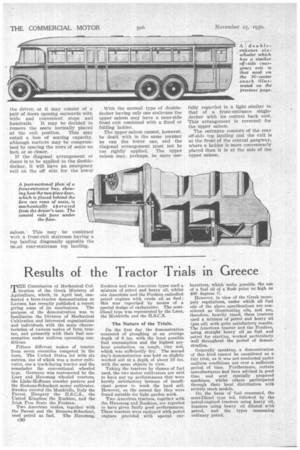Results of the Tractor Trials in Greece
Page 52

If you've noticed an error in this article please click here to report it so we can fix it.
MEM Commission of Mechanical Cul
tivation of the Greek Ministry of Agriculture, which, in April last, conducted a farm-tractor demonstration at Larissa, bas recently published a report giving some of its conclusions. The purpose of the demonstration was to familiarize the Division of Mechanical Cultivation and interested organizations and individuals with the main characteristics of various makes of farm tractor, and primarily with their fuel consumption under uniform operating conditions.
Fifteen different makes of tractor from seven countries competed in the tests. The United States led with six entries, one of which was a motor cultivator, one a track-laying tractor and the remainder the conventional wheeled type. Germany was represented by the Lanz and Hanomag wheeled tractors, the Linke-Hoffman crawler pattern and the Siemens-Sehuckert motor cultivator. Sweden entered the Munktells, Italy the Pavesi' Hungary the H.S.C.S., the United Kingdom the Rushton, and the Irish Free State the Fordson.
Two American makes, together with the Pavesi and the Siemens-Schuekert, used petrol as fuel. The Hanomag, C30 Rushton and two American types used a mixture of petrol and heavy oil, whilst one American and the Fordson embodied petrol engines with crude oil as fuel ; this was vaporized by means of a special design of carburetter. The semiDiesel type was represented by the Lanz, the Munktells and the H.S.C.S.
The Nature of the Trials.
On the first day the demonstration consisted of ploughing at an average depth of 6 ins, with the least possible fuel consumption and the highest perhour production on tough,. clay soil, which was sufficiently dry. The second day's demonstration was held on slightly worked soil at a depth of about 10 ins. with the same objects in view.
Taking the tractors by classes of fuel used, the two motor cultivators are said to have put up performances that were hardly satisfactory because of insufficient power to work the hard soil. However, on the second day they were found suitable for light garden work.
Two American tractors, together with the Hanomag and Rushton, are reported to have given fairly good performances. These tractors were equipped with petrol engines provided with special car
buretters, which make possible the use of a fuel oil of a flash point as high as 400 degrees C.
However, in view of the Greek monopoly regulations, under which all fuel • oils of the above specifications are considered as illuminating oils, and are, therefore, heavily taxed, these tractors used a mixture of petrol and heavy oil (gas oil) with quite satisfactory results. The American tractor and the Fordson, using straight heavy oil as fuel aud Petrol for starting, worked particularly well throughout the period of demonstration.
Generally speaking, a demonstration of this kind cannot be considered as a fair trial, as it was not conducted under uniform conditions nor over a sufficient period of time. Furthermore, certain manufacturers had been advised in good time and sent specially prepared machines, whilst others participated through their local distributors with strictly stock models.
On the basis of fuel consumed, the semi-Diesel type led, follotved by the petrol-engined tractors using heavy oil, tractors using heavy oil diluted • with petrol, and the types consuming ordinary petrol.












































































































